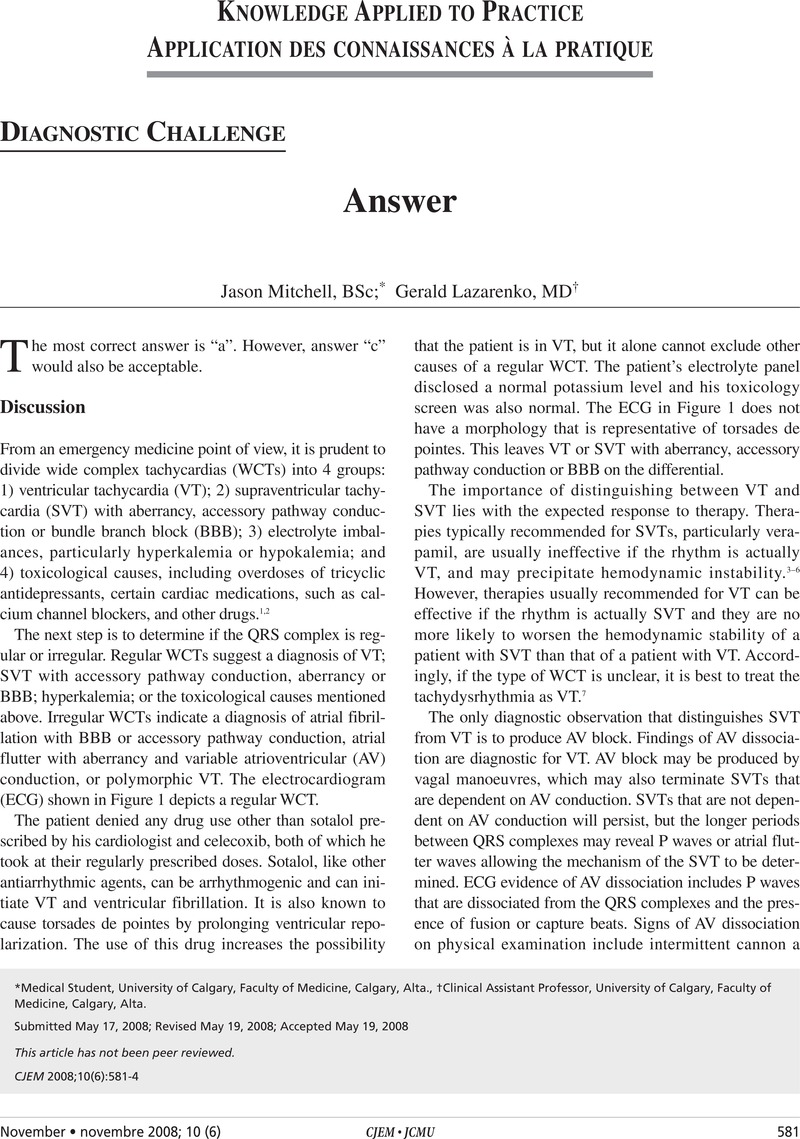No CrossRef data available.
Article contents
Answer
Published online by Cambridge University Press: 21 May 2015
Abstract
An abstract is not available for this content so a preview has been provided. As you have access to this content, a full PDF is available via the ‘Save PDF’ action button.

Keywords
- Type
- Knowledge Applied to Practice Application des connaissances à la pratique
- Information
- Copyright
- Copyright © Canadian Association of Emergency Physicians 2008
References
1.Holstege, CP, Eldridge, DL, Rowden, AK. ECG manifestations: the poisoned patient. Emerg Med Clin North Am 2006;24:159–77.CrossRefGoogle ScholarPubMed
2.Wald, DA. ECG manifestations of selected metabolic and endocrine disorders. Emerg Med Clin North Am 2006;24:145–57.Google Scholar
3.Stewart, RB, Bardy, GH, Greene, HL. Wide complex tachycardia: misdiagnosis and outcome after emergent therapy. Ann Intern Med 1986;104:766–71.Google Scholar
4.Dancy, M, Camm, AJ, Ward, D. Misdiagnosis of chronic recurrent ventricular tachycardia. Lancet 1985;2:320–3.CrossRefGoogle ScholarPubMed
5.Buxton, AE, Marchliski, FE, Doherty, JU, et al.Hazards of intravenous verapamil for sustained ventricular tachycardia. Am J Cardiol 1987;59:1107–10.Google Scholar
6.Garratt, C, Antoniou, A, Ward, D, et al.Misuse of verapamil in pre-excited atrial fibrillation. Lancet 1989;8:367–9.CrossRefGoogle Scholar
7.Zipes, DP, Camm, AJ, Borggrefe, M, et al.ACC/AHA/ESC 2006 guidelines for management of patients with ventricular arrhythmias and the prevention of sudden cardiac death: a report of the American College of Cardiology/American Heart Association Task Force and the European Society of Cardiology Committee for Practice Guidelines: developed in collaboration with the European Heart Rhythm Association and the Heart Rhythm Society. Circulation 2006;5:e385–484.Google Scholar
8.Shah, CP, Thakur, RK, Xie, B, et al.Clinical approach to wide QRS complex tachycardias. Emerg Med Clin North Am 1998;16:331–60.CrossRefGoogle ScholarPubMed
9.Baerman, JM, Morady, F, DiCario, LA, et al.Differentiation of ventricular tachycardia from supraventricular tachycardia with aberration: value of the clinical history. Ann Emerg Med 1987;16:40–3.Google Scholar
10.Tchou, P, Young, P, Mahmud, R, et al.Useful clinical criteria for the diagnosis of ventricular tachycardia. Am J Med 1988;84:53–6.Google Scholar
11.Morady, F, Baerman, JM, DiCarlo, LA Jr, et al.A prevalent misconception regardingwide-complex tachycardias. JAMA 1985;254:2790–2.Google Scholar
12.Spice, C, Stewart, K. Misdiagnosis of ventricular tachycardia. Lancet 1999;354:2165.Google Scholar
13.Brugada, P, Brugada, J, Mont, L, et al.A new approach to the differential diagnosis of a regular tachycardia with a wide QRS complex. Circulation 1991;83:1649–59.Google Scholar
14.Eckardt, L, Breithardt, G, Kirchhof, P. Approach to wide complex tachycardias in patients without structural heart disease. Heart 2006;92:704–11.Google Scholar




